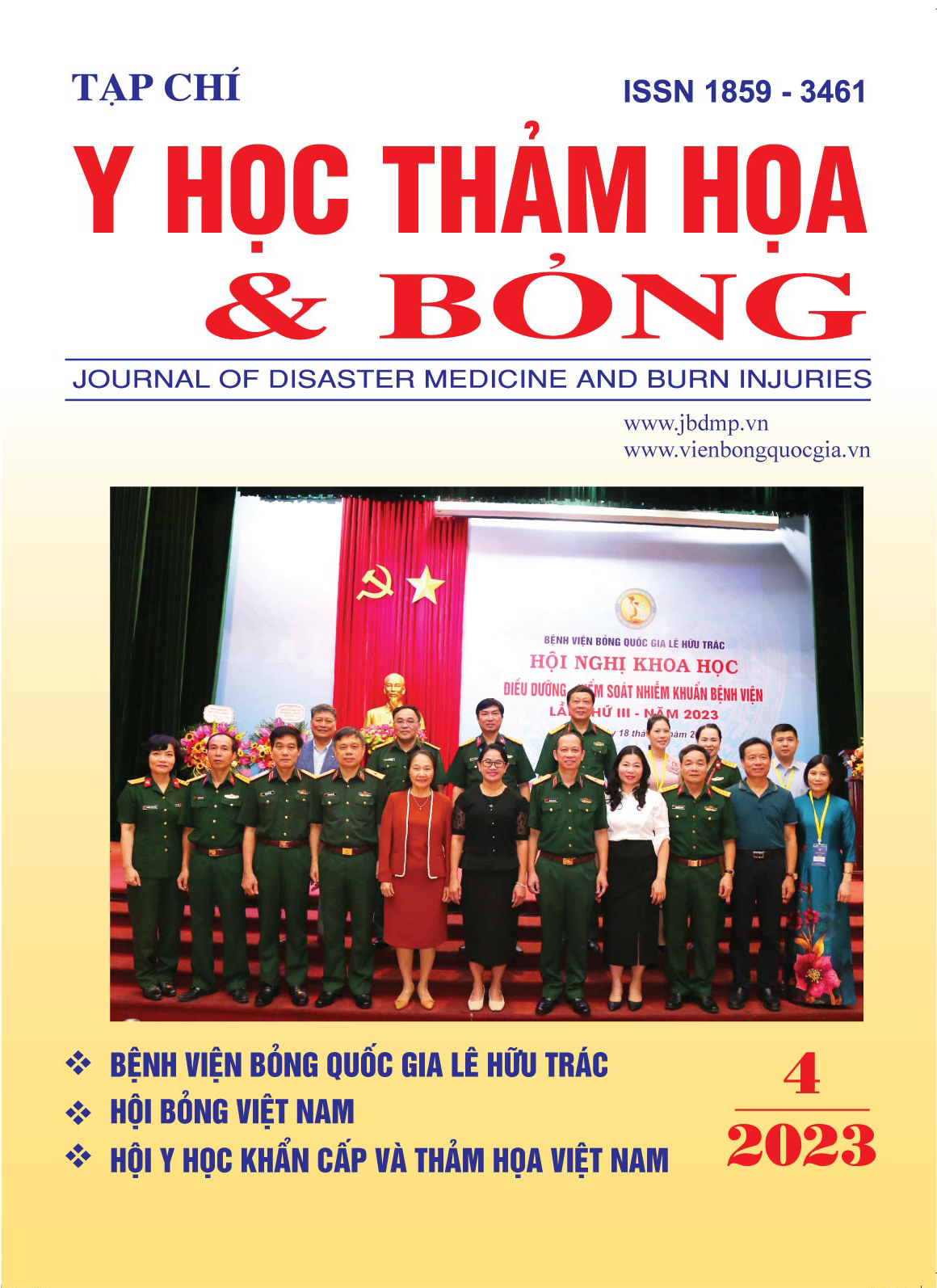Characteristics of early coagulopathy in severe burn patients
Main Article Content
Abstract
Objectives: To evaluate characteristics of early coagulopathy in severe burn patients.
Subjects and methods: Retrospective study of 93 adult burn patients (16 - 65 years old), without comorbidity and trauma, with burn >= 30% of total body surface area (TBSA), hospitalized within 24 hours after burn, inpatient treatment > 3 days at the ICU, have confirmed treatment result (survival or death). Early coagulopathy in severe burn patients was defined as INR > 1.5 or aPTT > 60 s within the first 24 hours after burn.
Results: The rate of coagulopathy was 46.24%. Laboratory tests at hospitalized, PT values mainly decreased (61.29%); INR and Fibrinogen were primarily increased (73.12% and 52.69%). The group of patients with early coagulopathy had a deep burn area, the number of ventilator patients and the arterial blood lactate concentration at admission was significantly higher (p < 0.05) compared with the group without early coagulopathy; while, the temperature at admission was significantly lower (p < 0.05). The patients with early coagulopathy had a 3.5 times higher risk of early acute renal failure and a 3.2 times higher risk of death than patients without, the difference was statistically significant (p < 0.05).
Conclusion: The rate of early coagulopathy in severe burn patients is still high. Increased deep burn area, lactate and hypothermia were factors associated with early coagulopathy. Early coagulopathy was associated with complications of early acute renal failure and mortality in severe burns patients.
Article Details
Keywords
coagulopathy, severe burns
References
2. Davenport R, Manson J, De’Ath H, Platton S, Coates A, Allard S, Hart D, Pearse R, Pasi KJ, MacCallum P (2011) Functional definition and characterisation of acute traumatic coagulopathy. Critical care medicine, 39(12):2652.
3. Brohi K, Cohen MJ, Davenport RA (2007) Acute coagulopathy of trauma: mechanism, identification and effect. Current opinion in critical care, 13(6):680-685.
4. Lavrentieva A, Kontakiotis T, Bitzani M, Papaioannou-Gaki G, Parlapani A, Thomareis O, Tsotsolis N, Giala M-A (2008) Early coagulation disorders after severe burn injury: impact on mortality. Intensive care medicine, 34:700-706.
5. Mitra B, Wasiak J, Cameron PA, O’Reilly G, Dobson H, Cleland H (2013) Early coagulopathy of major burns. Injury, 44(1):40-43.
6. Khwaja A (2012) KDIGO clinical practice guidelines for acute kidney injury. Nephron Clinical Practice, 120(4):c179-c184.
7. Clark A, Neyra JA, Madni T, Imran J, Phelan H, Arnoldo B, Wolf SE (2017) Acute kidney injury after burn. Burns, 43(5):898-908.
8. Sherren P, Hussey J, Martin R, Kundishora T, Parker M, Emerson B (2013) Acute burn-induced coagulopathy. Burns, 39(6):1157-1161.
9. Geng K, Liu Y, Yang Y, Ding X, Tian X, Liu H, Yan H (2020) Incidence and prognostic value of acute coagulopathy after extensive severe burns. Journal of Burn Care & Research, 41(3):544-549.
10. Garcıa-Avello A, Lorente J, Cesar-Perez J, Garcıa-Frade L, Alvarado R, Arevalo J, Navarro J, Esteban A (1998) Degree of hypercoagulability and hyperfibrinolysis is related to organ failure and prognosis after burn trauma. Thrombosis Research, 89(2):59-64.
11. Lippi G, Ippolito L, Cervellin G (2010) Disseminated intravascular coagulation in burn injury. Seminars in thrombosis and hemostasis, 36(04):429-436.


